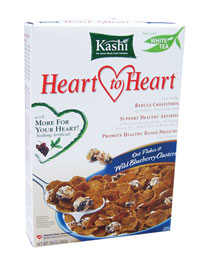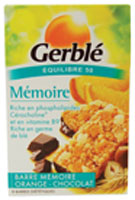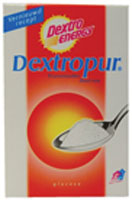

First introduced in the fall of 2001, the Kashi Heart to Heart branded cereal is a teacher in itself in regards to popular health ingredients. This reformulation notes the addition of white tea extract.
As a result, cereal has become a ubiquitous part of Americans’ diets. According to Mintel, 85% of consumers have eaten cold cereal in the last three months, leading to $6.1 billion in 2007 U.S. sales. Although bars are less commonly eaten than cereal, they have experienced tremendous recent growth. Mintel reports that the U.S. cereal bar market grew 43% at current prices from 2002-2007 and netted $1.6 billion in 2007 sales (including Wal-Mart).
Since so many Americans eat cereals and bars, it is not surprising that those categories reflect today’s most important food trends. In 2007, kosher was the most popular claim across all foods and beverages, and cereals and bars were no exception. According to Mintel Global New Products Database (GNPD), kosher claims grew 141% for cereal and 97% for snack/cereal/energy bars between 2005-2007 in the U.S. It is likely that food safety and health concerns play important roles in the rise of kosher foods. Mintel’s 2005 kosher food report shows that more than half of American consumers eat kosher foods, because they consider these products to be safer or healthier than non-kosher items. In a year where nutrition was a leading consumer driver, and food safety scares were numerous and prominent, kosher cereals and bars were particularly well-positioned.
For many of the most important cereal and bar trends, 2007 was a continuation of the previous year. Whole grains still play an important role in cereals and bars, bolstered by their association with health and wellness. Among U.S. cereals, these nutritious ingredients were especially active. According to Mintel GNPD, whole grain was the category’s second most popular claim in 2007, growing nearly 60% from the previous year. Although whole grains did not experience the same growth in bars, they were still included in almost 100 new U.S. products last year.

Among snack, cereal and energy bars in the U.S., organic claims outnumbered natural ones and also grew at a much faster pace. However, among cereals, all-natural claims grew more rapidly than did organic claims.
In 2007, health and wellness concerns went beyond whole grains and trans fat. It was a watershed year for nutrition self-regulation, as some of the industry’s most prominent players pledged to help children make healthier food choices. In July, 11 leading companies promised to ban advertising of unhealthy foods and drinks to children under 12. As part of their pledge, many companies planned to reformulate some of their products to make them more nutritious for young consumers. Cereal and bar giants General Mills, Kellogg, PepsiCo and Kraft were among the companies that agreed to the self-regulation.
In particular, Kellogg used 2007 to transform its portfolio into one of greater nutritional value for children. The company announced that the food it markets to children under 12 would contain no more than 12g of sugar per serving, along with a maximum of 2g of saturated fat and 230mg of sodium. In an equally bold move, Kellogg began to phase in new nutrition panels on the front of its cereal packages. These panels are intended to provide at-a-glance nutrition and highlight calorie, fat and sugar content, among other attributes.
Growing obesity concerns prompted other manufacturers to focus on weight management in 2007. Many U.S. companies relied on traditional methods, such as reducing or eliminating fat, calories and sugar, to make their products more appealing to weight-conscious consumers. According to Mintel GNPD, low-/no-/reduced-fat claims appeared among the top 10 for both cereals and bars, while low-/no-/reduced-sugar and -calorie claims increased in both categories, from 2006-2007.

The concepts of satiety and sustained energy--both of which are important to weight management--also began to emerge in cereals and bars last year. Both concepts adhere to the principle that keeping consumers feeling fuller longer helps control cravings, provides energy throughout the day and enhances weight control efforts. In 2007, some of these products were targeted to serious athletes who rely on sustained energy for maximum performance. Cytosport’s new Muscle Milk Bars, for instance, contain 25g of protein for energy throughout the day.
Other products were developed for a more mainstream audience. In the U.K., Kellogg launched Sustain, a cereal made with a blend of protein and fiber to keep hunger at bay. Although satiety positioning in the U.S. has been confined primarily to the dairy category, the launch of a satiety cereal by a major manufacturer indicates that there is tremendous potential for this concept across the Atlantic, as well.

There is no doubt that natural and organic are having a profound impact on bars and cereals. However, these trends may be giving way to the newest expression of health and wellness--simple and unadulterated foods. This “back to basics” approach focuses on fundamental attributes such as pure, real and healthy, and it shuns formal labeling in favor of all-around goodness. Quaker recently launched a snack bar that embodies the principles of simple food. Its Simple Harvest All Natural Fruit & Nut Bar contains real fruit and nuts and is sweetened with organic agave syrup. Several other bars and cereals introduced in 2007 also relied on natural sweeteners, such as cane juice, to replace high-fructose corn syrup and artificial sweeteners.
Just as natural and organic have become mainstream wellness issues, allergens and gluten sensitivity have also risen to prominence in cereals and bars. Widespread media attention has been paid to these conditions, although the actual number of consumers affected by them is widely debated. The American Academy of Allergy, Asthma and Immunology claims that more than 12 million Americans have food allergies, while WebMD reports that as many as three million Americans suffer from gluten intolerance.
Regardless of the actual incidence of food allergies and gluten sensitivity, manufacturers have launched products to address these conditions in record numbers. From 2006-2007, low-/no-/reduced-allergen and gluten-free claims have doubled or nearly doubled for U.S. bars and cereals. Some products launched last year position themselves exclusively on these “free-from” platforms. Glutino’s Gluten Free Breakfast Bars, for instance, are free from gluten, wheat and dairy.
One of the most exciting growth areas for bars and cereals surrounds functional ingredients. Although functional claims are still quite limited in these categories, they did show meaningful gains in 2007. Cardiovascular health was last year’s most active functional claim in U.S. cereals, with a 400% leap from the previous year. The prevalence of oats and whole grains in cold cereals makes heart health a natural fit for this category.
Among bars, digestive health was the most important functional food claim. Strengthened by the popularity of probiotic-rich yogurt, digestive health is no longer a taboo subject. Some cereals and bars are leveraging yogurt’s health halo to transfer its benefits to new categories. Leading brands, including Cheerios, Health Valley and Fruit Loops, launched yogurt-based cereals and bars in 2007, although these products do not enjoy the same probiotic benefits as real yogurt. By contrast, Attune Foods introduced a yogurt and granola wellness bar that includes more than five times the live active cultures found in regular yogurt. Whether it is enjoyed as a healthy flavor enhancement or the basis for digestive nutrition, yogurt will likely continue its run in cereals and bars in the coming years.
Beyond heart and digestive health, some of last year’s most interesting cereals and bars included functional ingredients that are just beginning to emerge in those categories. Pomegranate—America’s most popular superfruit—appeared in products like Target’s Archer Farms Pomegranate Fruits Bars and Weight Watchers’ Flakes ’n Pomegranate Select Cereal.
Other Notable 2007 Functional Ingredients and Launches Included
Goji berry:antioxidant-rich fruit used for centuries in traditional Chinese medicine to protect the liver, boost immunity and improve circulation, among other benefits (Peace Cereal Ginger Hemp Granola).Flax:seeds naturally high in omega-3s that contribute to heart and brain function (Nature’s Path Organic Flax Plus Pumpkin Raisin Crunch Cereal, Trader Joe’s Five Seed Almond Bars).
Ancient grains:grains such as spelt, amaranth, quinoa and teff that have been cultivated for thousands of years and feature nutrient-dense, wheat-free profiles (Arrowhead Mills Breadshop Ancient Grain Cereals, Quinoa Ancient Harvest Organic Quinoa Flakes).
The information in this article was partially derived from the Mintel Global New Products Database, www.gnpd.com, 312-932-0400.
Going Global
An old adage tells that getting older means becoming wiser. That may be true, but it has not stopped consumers around the world from turning to foods for a “brain boost.” Since 2005, mental function products have increased by more than 180%. According to Mintel GNPD, nearly 450 of these brain foods and drinks were launched in 2007 alone. Some mental function products focus on short-term stimulation, while others are designed for longer-term mental performance.Bars are ideal vehicles for delivering these mental function benefits. In Canada, Niche Brands’ Red Rush High Energy Chocolate Bar relies on ingredients traditionally found in energy drinks. The product contains caffeine, taurine and guarana for a temporary boost of mental alertness. A line of energy bars in Europe takes a different approach to short-term stimulation. Dextro Energy formulates its Yogurt Flavored Energy Bars with high levels of glucose to stimulate the brain and improve concentration.
Consumers of all ages can benefit from mental function bars, but seniors may be particularly interested in these products. In France, the Gerblé brand has introduced Balance 50 Memory cereal bars especially for older consumers. The product claims to help seniors “maintain their mental vivacity” and relies on folic acid and wheat germ to provide brain-boosting benefits.
PHOTOS COURTESY OF MINTEL GNPD